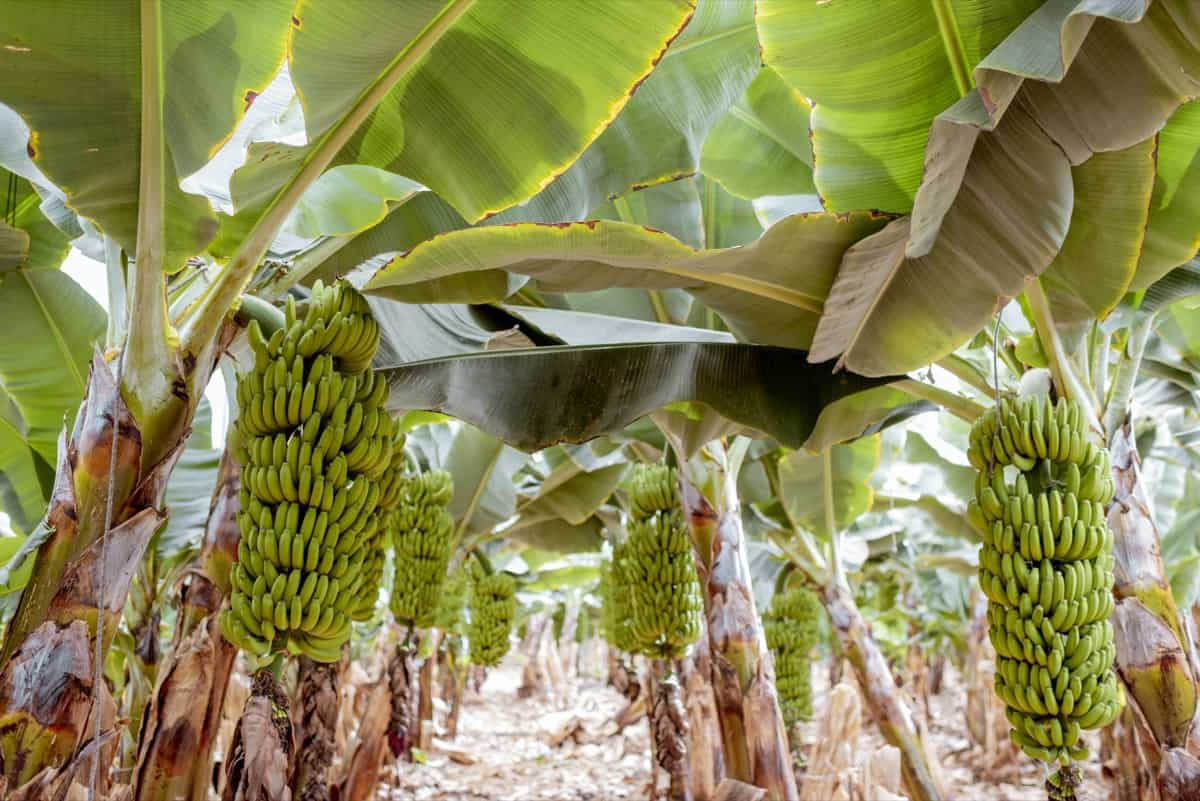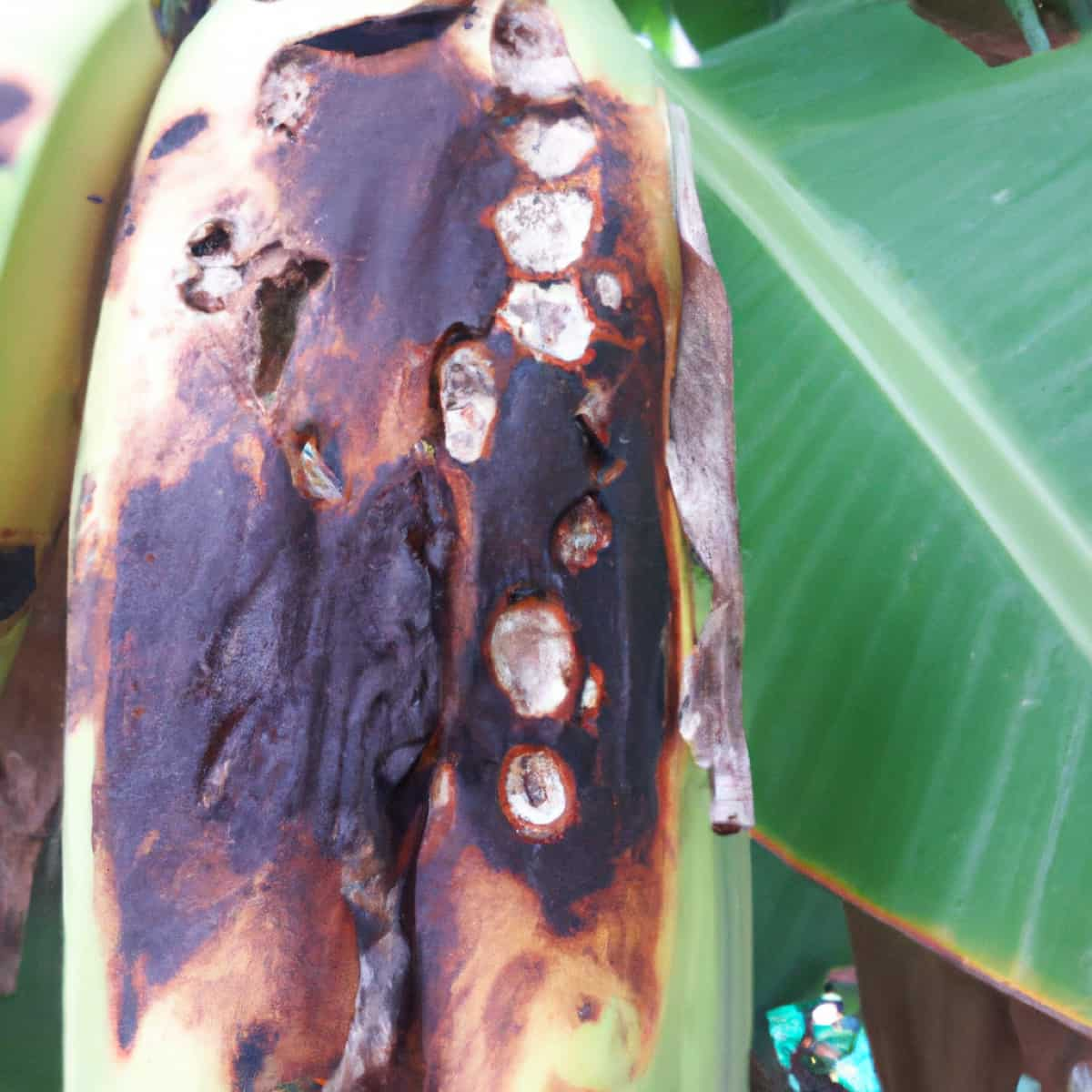The Banana Anthracnose Disease is caused by the fungus Gloeosporium musarum is a serious disease that affects banana crops worldwide. The economic impact of Banana Anthracnose Disease is significant, as it reduces fruit yield, quality, and marketability and can result in the complete loss of yield. This disease attacks the flowers, epidermis, and distal ends of banana heads.

It is considered one of the most destructive diseases of bananas and has been responsible for significant crop losses in many countries. The disease can spread through infected plant material, tools, and machinery and persist in the soil for many years. Effective management of banana anthracnose requires a combination of cultural, biological, and chemical control measures.
Early detection and prompt implementation of control measures can help prevent the spread of the disease and minimize yield losses. To effectively manage this disease, it is important to understand its disease cycle, the mode of disease spread, and the best methods for controlling it. This article will provide an overview and discussion of the Banana Anthracnose Disease in Banana crops, including its symptoms, identification techniques, and control.
Banana Anthracnose Disease Management
The Causal Organism of Banana Anthracnose Disease
- Gloeosporium musarum is a hemibiotrophic fungus that belongs to the Family Dermateaceae of Order Helotiales of the Phylum Ascomycota. It is formerly known as Colletotrichum musae.
- The pathogen produces spores called conidia, dispersed by wind and water to other parts of the plant or other banana plants.
- The pathogen can survive in infected plant debris and soil for several months, making it difficult to control.
The Disease Cycle of Banana Anthracnose Disease
- The disease cycle of the Banana Anthracnose disease, Gloeosporium musarum, in Banana Crops, begins with the fungal spores entering the banana plant through wounds or natural openings such as stomata.
- It has a two-stage infection process. The pathogen initially colonizes the plant surface through specialized infection structures called appressoria, which penetrate the plant cuticle and form a feeding structure known as the primary hyphae. These primary hyphae grow in the intercellular spaces of the plant and gradually spread through the tissue, causing localized tissue death and the formation of dark, sunken lesions.
- In the second stage of infection, the pathogen switches to a necrotrophic phase, secreting toxic compounds that cause rapid tissue death and decay.
- The conidia are also produced on the lesion’s surface and can be easily spread by human activity such as pruning or harvesting.
- The fungus can survive in infected plant debris and soil for several months, making it difficult to control. During this time, the fungus can continue to produce spores that can infect new plants.
Occurrence of Banana Anthracnose Disease in Banana Crop
- Location of Banana Anthracnose disease: This disease occurs in Banana crops in India, Africa, China, Bangladesh, Sri Lanka, Vietnam, Thailand, Indonesia, Malaysia, the Philippines, the United States, Mexico, Brazil, Colombia, Ecuador, Peru, and Australia.
- Host range: The most common crops affected by Gloeosporium musarum are Banana, Plantains, Pineapple, Papaya, Mango, Avocado, Oranges, Lemons, and Grapefruits.
Favorable Conditions for Banana Anthracnose Disease Spread in the Field
- High temperatures, humidity, and rainfall favor the disease’s development and spread.
- The disease is more prevalent during warm weather conditions, with the optimum temperature being 25 to 30°C and high relative humidity of 80-100%.
- The disease incidence is usually high during the rainy season when the weather conditions favor the growth and spread of the fungus.
- The presence of wounds or injuries on the banana fruit or plant tissues provides an entry point for the fungal spores, leading to increased disease severity.
- The fungus can also infect banana fruits during the ripening stage, leading to fruit rot and a significant loss in yield.
- Poor management practices, such as using infected planting material and inadequate crop hygiene measures, can also favor the development and spread of the disease.
In case you missed it: Banana Panama Wilt Disease Management: Symptoms, Treatment, Chemical, Biological, and Organic Control

Damage Symptoms of Banana Anthracnose Disease
- The disease is characterized by the appearance of dark, sunken lesions on the fruit, stems, and leaves of the banana plant.
- The lesions can become enlarged and coalesce, destroying entire bunches and causing significant economic losses for banana farmers.
- The epidermal layers of the fruit turn black and get covered with characteristic pink acervuli. Later, the whole finger is affected, which damages the complete bunch.
- The pedicels affected by the lesions will drop the fingers.
- This disease can also result in premature ripening and fruit shriveling covered with pink spores.
Percentage of Yield Loss Due to Banana Anthracnose Disease in Banana Crop
- The disease can cause 20% yield losses in the United States. In Mexico, yield losses are 50%. In India, the yield losses are 20-60%. In Bangladesh, the losses are 70%. In Sri Lanka, the losses are 10-30%. In China, a 50% yield loss is seen. In Africa, yield losses are up to 40%.
- In Indonesia, it is 50%. In Vietnam, it is 50%. In Ecuador, it is 50%. In Peru, it is 30%. In the Philippines, it is 50%. In Malaysia, it is 60%. In Colombia, it is 70%. In Thailand, it is 60%. In Brazil, it is 40%. In Australia, the losses are 20%. The Economic Threshold Level is determined at 10-15% fruit infection.
Cultural Control Measures of Banana Anthracnose Disease
- Prevent or reduce mechanical injuries and bruising during harvesting and transport.
- Store the banana yields at 13-15 °C in cold storage to prevent infections.
- Ensure proper drainage facilities in the soil and perform regular weeding in the field.
- The field should be kept clean by removing and burning all infected plants.
- Disinfect tools and equipment and avoid soil movement from infested to disease-free fields.
- Harvest the crops at the right time after maturing.
- Proper soil management practices, such as improving soil fertility, can help reduce the severity of the disease in the crops.
Biological Control Measures of Banana Anthracnose Disease
- Trichoderma harzianum and Gliocladium virens are beneficial fungi that parasitize the pathogen, produce antibiotics that inhibit its growth, and induce plant defenses against it.
- Bacillus subtilis are beneficial bacteria that colonize the banana plant’s surface and produce antibiotics that suppress the growth and activity of the pathogen.
Chemical Control Measures of Banana Anthracnose Disease
- Spray Mancozeb, Zineb, Tebuconazole, Propiconazole, Bavistin, Chlorothalonil, or Carbendazim until two months at 15 days intervals to control the fungus spread.
- Dipping – Dip the fruits in Carbendazim, Aureofungin sol, or Benomyl after harvesting them and before storage.
Organic Control Measures of Banana Anthracnose Disease
- Plant extracts from neem, ginger, garlic, and turmeric leaves, such as powders, oils, and cakes, are used as a foliar spray or incorporated into the soil to suppress the disease.
- Tea tree oil, thyme oil, oregano oil, clove oil, and cinnamon oil disrupt the pathogen’s cell membrane, causing it to die.
- Spray Copper-based fungicides, such as copper sulfate, copper oxychloride, and copper hydroxide. They inhibit spore germination and prevent fungal growth.
Preventive Measures for Control of Banana Anthracnose Disease
- Use disease-free, healthy, and certified planting material only.
- Always use sterilized and disinfected pruning equipment to prevent the spread of the disease to new trees.
- Regularly monitoring the crops for signs of disease will help to find and manage the disease early before it spreads.
- Proper irrigation management, such as drip irrigation and avoiding waterlogging, can help reduce the risk of this pathogen in banana crops.
In case you missed it: Banana Scab Moth Pest Management: Symptoms, Treatment, Chemical, Biological, and Organic Control

Conclusion
The Banana Anthracnose Disease caused by Gloeosporium musarum is a significant threat to banana production and causes significant economic losses globally. Integrated disease management strategies can effectively manage the disease, including cultural, biological, chemical, and preventive control measures.
- Deworming Schedule for Dogs/Puppies: A Beginners Guide
- How to Prevent and Control Parasites in Goats
- Beneficial Insects in Pest Management
- Natural Solutions for Pest Control in Flower Gardens
- Types of Fungicides Used in Agriculture
- Common Issues in the Fruit Development Stage of Pomegranate Farming
- Fruit Development Issues in Papaya: Easy Solutions and Treatment
- Soil-Borne Diseases and How to Protect Your Plants
- Practices to Prevent Disease Spread in the Garden